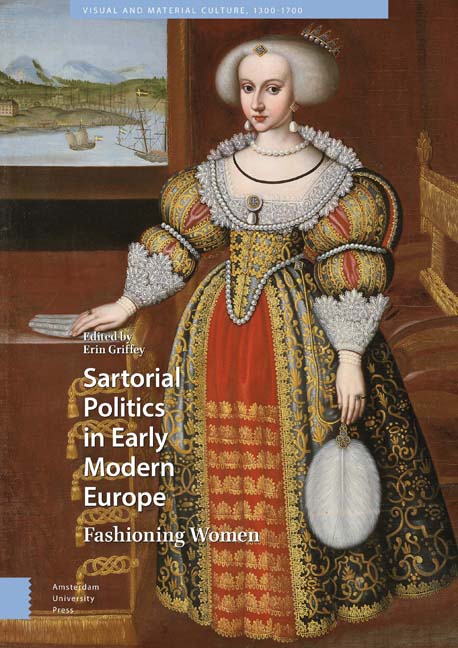Book contents
- Frontmatter
- Acknowledgements
- Contents
- List of Illustrations
- Introduction
- 1 Isabella d’Este's Sartorial Politics
- 2 Dressing the Queen at the French Renaissance Court: Sartorial Politics
- 3 Dressing the Bride: Weddings and Fashion Practices at German Princely Courts in the Fifteenth and Sixteenth Centuries
- 4 Lustrous Virtue: Eleanor of Austria's Jewels and Gems as Composite Cultural Identity and Affective Maternal Agency
- 5 Queen Elizabeth: Studded with Costly Jewels
- 6 A ‘Cipher of A and C set on the one Syde with diamonds’: Anna of Denmark's Jewellery and the Politics of Dynastic Display
- 7 ‘She bears a duke's revenues on her back’: Fashioning Shakespeare's Women at Court
- 8 How to Dress a Female King: Manifestations of Gender and Power in the Wardrobe of Christina of Sweden
- 9 Clothes Make the Queen: Mariana of Austria's Style of Dress, from Archduchess to Queen Consort (1634–1665)
- 10 ‘The best of Queens, the most obedient wife’: Fashioning a Place for Catherine of Braganza as Consort to Charles II
- 11 Chintz, China, and Chocolate: The Politics of Fashion at Charles II's Court
- 12 Henrietta Maria and the Politics of Widows’ Dress at the Stuart Court
- Works Cited
- Index
3 - Dressing the Bride: Weddings and Fashion Practices at German Princely Courts in the Fifteenth and Sixteenth Centuries
Published online by Cambridge University Press: 21 November 2020
- Frontmatter
- Acknowledgements
- Contents
- List of Illustrations
- Introduction
- 1 Isabella d’Este's Sartorial Politics
- 2 Dressing the Queen at the French Renaissance Court: Sartorial Politics
- 3 Dressing the Bride: Weddings and Fashion Practices at German Princely Courts in the Fifteenth and Sixteenth Centuries
- 4 Lustrous Virtue: Eleanor of Austria's Jewels and Gems as Composite Cultural Identity and Affective Maternal Agency
- 5 Queen Elizabeth: Studded with Costly Jewels
- 6 A ‘Cipher of A and C set on the one Syde with diamonds’: Anna of Denmark's Jewellery and the Politics of Dynastic Display
- 7 ‘She bears a duke's revenues on her back’: Fashioning Shakespeare's Women at Court
- 8 How to Dress a Female King: Manifestations of Gender and Power in the Wardrobe of Christina of Sweden
- 9 Clothes Make the Queen: Mariana of Austria's Style of Dress, from Archduchess to Queen Consort (1634–1665)
- 10 ‘The best of Queens, the most obedient wife’: Fashioning a Place for Catherine of Braganza as Consort to Charles II
- 11 Chintz, China, and Chocolate: The Politics of Fashion at Charles II's Court
- 12 Henrietta Maria and the Politics of Widows’ Dress at the Stuart Court
- Works Cited
- Index
Summary
Abstract
Marriages between the aristocratic elite played an important role in the exchange of fashion at early modern European courts. Because bridal couples usually came from different regions or countries, different styles of clothing came into contact at the wedding celebration as well as afterwards, when the bride started living at her husband’s court. Focussing on princely German courts in the fifteenth and sixteenth centuries, this paper shows how noble women took their natal dress with them to their marital court and how the court reacted to their foreign style. By analysing the dress practices of noble women, this essay looks into the political potentials of dress and the shaping of identities of the female elite at German courts.
Key words: German courts; dowry; trousseau; dress practices; foreign style; wedding
In the late Middle Ages, kinship ties within the European aristocracy were of major importance for cultural exchange processes at princely courts. A relatively dense network of marriage relationships formed the basis for a wide range of different contacts; and the increasing mobility towards the end of the Middle Ages intensified this even further. These relationships also favoured the exchange and communication of princely fashions between different regions and countries. During the subsequent transition from the Middle Ages to the early modern period by the end of the fifteenth and the beginning of the sixteenth century, princely dress practices were not just determined socially but also and above all culturally. Anchored in specific life worlds, they maintained not only social position, lineage, and/or family status, but also specific, although not clearly circumscribed, geographical spaces. Contemporaries already registered differences between domestic and foreign princely dress very precisely and assumed that there were several simultaneously coexisting, spatially linked fashions. Envoys and emissaries who helped communicate news and cultivate social contacts reported on dress customs at other courts, and they frequently took robes or fabrics home as presents. Aristocrats receiving their training at several different courts also spread knowledge about foreign dress styles. However, what were likely even more significant for the exchange of fashions were the personal meetings between the aristocrats themselves that occurred – frequently on the basis of existing familial ties – within, for example, the framework of court feasts, longer stays for educational and training purposes, and political negotiations or visits.
- Type
- Chapter
- Information
- Sartorial Politics in Early Modern EuropeFashioning Women, pp. 75 - 92Publisher: Amsterdam University PressPrint publication year: 2019



